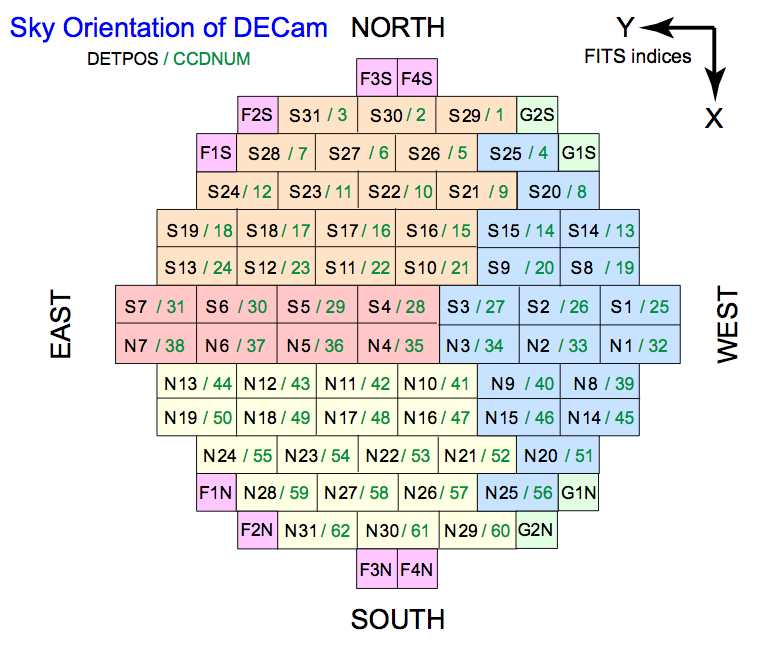DECam Characteristics
Main Characteristics of Focal Plane
| Field of View | 3 square degree (2.2 degree field of view) |
| Pixel scale | 0.2637 arcsec/pixel (center), 0.2626 arcsec/pixel (edge) |
| Detector | 62, 2048x4096 pixel red-sensitive science CCDs from LBNL, 520 megapixels total (570 Mpix including guide and focus CCDs) |
| Read-out noise | 7e- |
| Read-out time | 20 seconds |
| Dark-current | ~ |
| QE | 40% at 400 nm, 70% at 520 nm, then around 90% until 920 nm, falling to 40% at 1000 nm, 10% at 1050 nm |
| Dynamical range | 16 bit |
| Inter-CCD Gaps | 3.0 mm (201 pixels) along long edge (e.g., between S4 and N4); 2.3 mm (153 pixels) along short edge (e.g., between N4 and N5) |
| Cosmetics | Good to excellent. On average, each CCD has 0.05% bad pixels and the worst CCD has 0.39% bad pixels. |
| Filters | 8 filters now available (ugrizY, wide VR, narrow N964) |
| Gain | 4 e-/ADU (typica) |
| Non linearity, | For normal observing, keep level below 100,000 e-, 22,000 ADU |
| Raw data format | FITS (with extensions),1 GB/file, ~600 Mbyte/file compressed |
| Instrument F ratio | f/2.7 |
| Available filters | u g r i z Y VR N964 |
The figure below shows the orientations on the sky and spatial footprint of the focal plane array.
The 2k x 2k CCDs labeled as "F" are used for focus and alignment control; those labeled as "G" are used for guiding. The detector position numbers (e.g., "S4" or "N4" near the center of the field) are useful for identifying specific CCDs to look at in the multi-extension images, like "display DECam_00153116.fits[N4]"). Note that CCD N30 is not functional. CCD S30 was not functional 2014-2016.
When working with the data, both at the telescope (real time display) and off disk (default ds9 view), the images are often displayed in "pixel orientation". The figure below shows the orientation of the field and CCDs in pixel orientation.
Example images can be downloaded from the NOIRLab Astro Data Archive.
Current gain and readnoise values for all CCDs/Amplifiers can be found in either the image headers or here.
Here is the pixel scale distortion map (courtesy Mischa Schirmer).Compared to most prime-focus systems. DECam has very low distortion.
Further information can be found in the DECam Data Handbook.
Updated on May 26, 2021, 5:22 am


